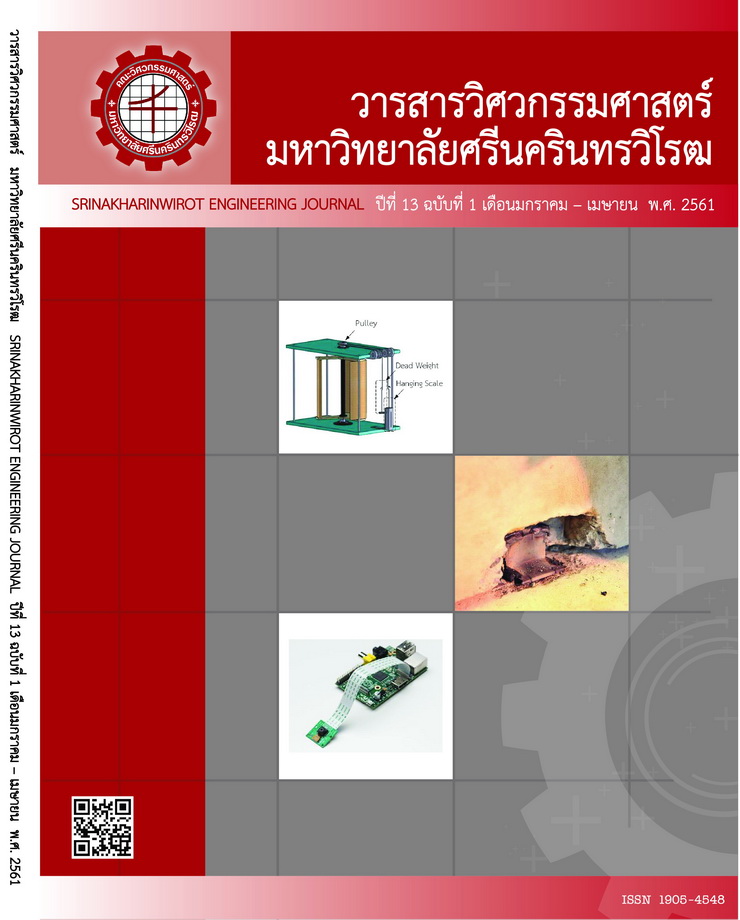Solving Line Balancing and Allocation Multi-Skilled Workers Problem on Parallel Assembly Line under Many-Objective
Main Article Content
Abstract
A multi-objective evolutionary algorithm based on decomposition (MOEA/D) is an evolutionary meta-heuristic which uses the concept of solving problems with many objectives simultaneously by classification problem into various subproblems. This paper applies MOEA/D algorithm in conjunction with the bisection method for solving line balancing and allocation problems of multi-skilled workers whom some are disable on parallel assembly lines under four objectives, i.e. minimize cycle time, minimize the number of stations, minimize different workload between workstations, and minimize index of task-unrelated. The experiment results show that MOEA/D obtains better performance than the Combinatorial Optimization with Coincidence (COIN) algorithm in terms of convergence which is the main concern of algorithm comparison. Although, its spread and CPU time are inferior to COIN.
Article Details
Copyright belongs to Srinakharinwirot University Engineering Journal
References
[2] U. Özcan, "Balancing stochastic two-sided assembly lines: A chance-constrained, piecewise-linear, mixed integer program and a simulated annealing algorithm," Eur. J. Oper. Res., vol. 205, no. 1, pp. 81-97, 2010.
[3] O. Kilincci, "A Petri net-based heuristic for simple assembly line balancing problem of type 2," Int. J. Adv. Manuf. Technol., vol. 46, no. 1-4, pp. 329-338, 2009.
[4] A. A. Chaves, L. A. N. Lorena, and C. Miralles, "Hybrid Metaheuristic for the Assembly Line Worker Assignment and Balancing Problem," in Hybrid Metaheuristics: 6th International Workshop, HM 2009, Udine, Italy, October 16-17, 2009. Proceedings, M. J. Blesa, C. Blum, L. Di Gaspero, A. Roli, M. Sampels, and A. Schaerf, Eds. Berlin, Heidelberg: Springer Berlin Heidelberg, 2009, pp. 1-14.
[5] W. Zhang, M. Gen, and L. Lin, "A multiobjective genetic algorithm for Assembly Line Balancing problem with worker allocation," IEEE Trans. Syst. Man Cybern., pp. 3026-3033, 2008.
[6] F. F. B. Araújo, A. M. Costa, and C. Miralles, "Balancing parallel assembly lines with disabled workers," Eur. J. Ind. Eng., vol. 9, no. 3, p. 344, 2015.
[7] H. Gökçen, K. Ağpak, and R. Benzer, "Balancing of parallel assembly lines," Int. J. Prod. Econ., vol. 103, no. 2, pp. 600-609, 2006.
[8] Q. Zhang and H. Li, "MOEA/D: A Multiobjective Evolutionary Algorithm Based on Decomposition," IEEE Trans. Evol. Comput., vol. 11, no. 6, pp. 712-731, 2007.
[9] A. Scholl and N. Boysen, "Designing parallel assembly lines with split workplaces: Model and optimization procedure," Int. J. Prod. Econ., vol. 119, no. 1, pp. 90-100, 2009.
[10] A. Scholl, "Data of assembly line balancing problems," Darmstadt Technical University, Department of Business Administration, Economics and Law, Institute for Business Studies (BWL) 1995.
[11] D. Sparling and J. Miltenburg, "The mixed-model u-line balancing problem," Int. J. Prod. Res., vol. 36, no. 2, pp. 485-501, 1998.
[12] Y. K. Kim, Y. Kim, and Y. J. Kim, "Two-sided assembly line balancing: A genetic algorithm approach," Prod. Plann. Contr., vol. 11, no. 1, pp. 44-53, 2000.
[13] T. O. Lee, Y. Kim, and Y. K. Kim, "Two-sided assembly line balancing to maximize work relatedness and slackness," Comput. Ind. Eng., vol. 40, no. 3, pp. 273-292, 2001.
[14] D. E. Goldberg and R. Lingle, "Alleles, loci, and the traveling salesman problem," in Proceedings of an international conference on genetic algorithms and their applications, 1985, vol. 154, pp. 154-159: Lawrence Erlbaum, Hillsdale, NJ.
[15] ปารเมศ ชุติมา, ภาณุวัฒน์ โอฬารวิวัฒนชัย, วรินทร์ วัฒนพรพรหม, และ ประภาส จงสถิตย์วัฒนา, "การประยุกต์ใช้อัลกอริทึมการบรรจวบสำหรับปัญหาการจัดสมดุลสายการประกอบแบบลักษณะตัวยูที่ทำการผลิตผลิตภัณฑ์ผสมที่มีหลายวัตถุประสงค์ในระบบผลิตแบบทันเวลาพอดี," การประชุมทางวิชาการของมหาวิทยาลัยเกษตรศาสตร์ ครั้งที่ 47, 2552.
[16] P. Chutima and P. Olanviwatchai, "Mixed-Model U-Shaped Assembly Line Balancing Problems with Coincidence Memetic Algorithm," JSEA, vol. 3, no. 4, pp. 347-363, 2010.
[17] สถาพร โอฬารวิวัฒน์ชัย และ ปารเมศ ชุติมา, "การจัดลำดับการผลิตรถยนต์แบบหลายวัตถุประสงค์บนสายการประกอบผลิตภัณฑ์ผสมแบบสองด้าน," วารสารวิชาการพระจอมเกล้าพระนครเหนือ, vol. 24, no. 1, pp. 87-102, 2557.
[18] R. K. Hwang, H. Katayama, and M. Gen, "U-shaped assembly line balancing problem with genetic algorithm," Int. J. Prod. Res., vol. 46, no. 16, pp. 4637-4649, 2008.
[19] R. Kumar and P. K. Singh, "Pareto Evolutionary Algorithm Hybridized with Local Search for Biobjective TSP," in Hybrid Evolutionary Algorithms, A. Abraham, C. Grosan, and H. Ishibuchi, Eds. Berlin, Heidelberg: Springer Berlin Heidelberg, 2007, pp. 361-398.
[20] วัชรวิทย์ ถนนทอง, "การจัดลำดับผลิตรถยนต์แบบหลายวัตถุปรสงค์บนสายการประกอบผลิตภัณฑ์ผสมแบบสองด้านด้วยอัลกอริทึมการบรรจวบร่วมกับฟัซซี่," วิศวกรรมศาสตรมหาบัณฑิต, สาขาวิชาวิศวกรรมอุตสาหการ ภาควิชาวิศวกรรมอุตสาหการ, จุฬาลงกรณ์มหาวิทยาลัย, 2558.

